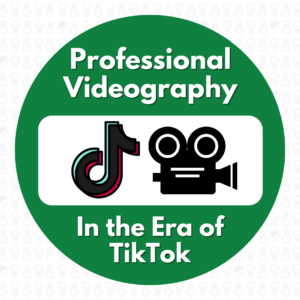Professional Video in the Era of TikTok
With almost everyone having access to a video camera, editing capabilities and distribution platforms in the palm of their hand, it can beg the question—where do professional videographers fit in? 
With the rise in popularity of social media video content, some professional videographers feel threatened by the ease with which content can be created. Certainly, apps like TikTok, an evolution from Vine and other meme-posting platforms, have legitimized a certain style and format of video production. The app has taught millions of users how to edit, add music and effects and post content with ‘viral’ capabilities (and to my chagrin, has made vertical video ‘normal’). But in our opinion, the apps just showcase the importance of storytelling. There is—and always has been—a desire to see and hear stories from others, and there’s always room for more than one type of storyteller.
So why should local governments with limited resources hire professional videographers who focus on things like the newest camera and editing trends, lighting, exposure and motion graphics?
The answer comes down to three things: message, audience and distribution.
- Message: What is the key takeaway people should have by the end of your video?
- Audience: Who are you trying to reach?
- Distribution: How will you reach your target audience?
When it comes to messaging, a challenge for most municipalities is the need to provide background and educational information from the get-go to get their message across, as not everyone has an understanding of the policies and processes associated with local governments. A professional can help distill a complex message into digestible information through both words and visuals and keep a viewer engaged with high-quality production, audio and graphics.
Identifying the intended audience early in the project is critical to setting the initial direction and budget. In reality, it’s one of the most important factors in determining the type of video you need to produce and if you need a professional approach. Sometime the target audience may not prefer a glitzy video, or the nature of the content needs to be reconsidered given the likely subject matter comfort level. Or it could simply be a question of what are the consumption behaviors of the audience.
Once you have your audience identified, you can then determine where they are most likely to consume your content. At Tripepi Smith, we have an axiom: Content x Distribution = Impact. Without a distribution strategy, content will die on the vine. Professionals have the data and experience to speak to the demographics on each platform, the types of content that perform best on each, budget recommendations and strategies to reach your goals. Balancing production costs with advertising and boosting fees is a real question that needs to be addressed early.
After considering these three factors, in some cases, a short video taken by City staff would suffice, but for more complex messages, professional videographers, marketers and communication professionals can provide guidance on how to engage the intended audience, get a key message across and distribute it in a way that provides the greatest return on investment.
Just like Canva hasn’t killed the need for graphic designers and smartphones haven’t replaced photographers, the rise of amateur video isn’t a substitute for professional videography. Instead, it showcases that storytelling isn’t about the equipment, but how professionals think critically and creatively about a project to craft visuals, images and stories in a way that can’t always be done with the touch of a button.


